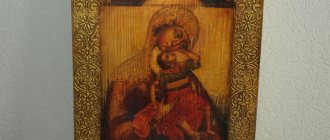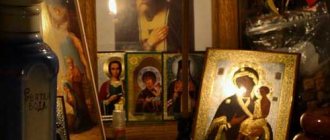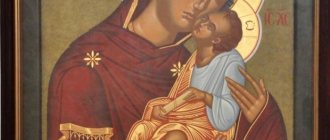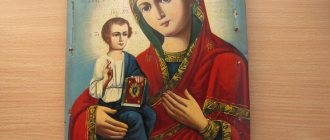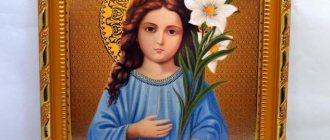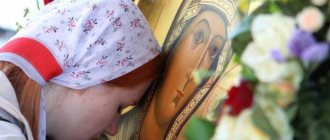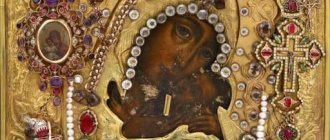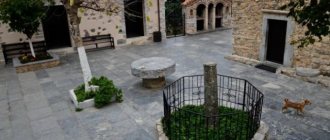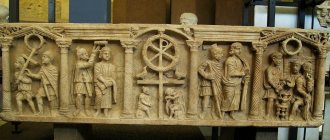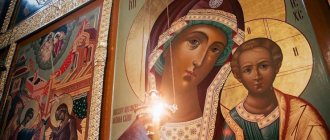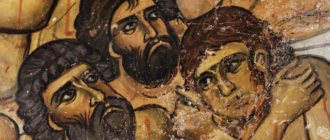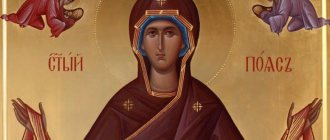The image of the Mother of God is special for Russia. Of course, in many Christian countries (and throughout Christian culture) the Virgin Mary enjoys great veneration, but it was in Rus' that for many years this image was not only actively cultivated, but also repeatedly allowed believers to find protection and hope. Many people know the Kazan and Vladimir icons of the Virgin Mary, but there are many other wonderful images.
The Mother of God is present not only in the temple, but also on the home altar. As the scriptures say, she is valued above all angelic ranks.
What is the meaning of the icon
The miraculous image depicts the baby Jesus sitting in the arms of his mother, the Blessed Virgin Mary. The image is filled with love and care for the child, because the Mother of God lightly touches her son with her cheek, in response Jesus extends his right hands to the Mother of God, as if playfully wanting to hug her. Virgo's gaze is very soft, full of love and affection. According to iconography, the “Leaping of the Baby” icon demonstrates the Lord’s attitude towards all his earthly children.
If you believe the legend, then baby Jesus was brought to the Lord’s temple on the fortieth day after his birth in order to undergo the sacrament of baptism. After the ceremony was completed, the son of God extended his small hands to his mother. According to legend, this very moment was taken as the basis for the plot of the icon “The Leaping of the Baby.”
The history of the miraculous image begins in 1795; the face was first seen within the walls of the Nikolo-Ugreshinsky monastery. The loss of the icon occurred during the October revolutionary actions, after which nothing was heard about it for a long time. The shrine was rediscovered only in 2003; the original “Baby Leaping” icon was brought to the temple by a parishioner.
Handwritten icon of Baby Leaping
Price from: 5 500
More details
Chapter 3. Image of the Mother of God “Tenderness” (“Caressing”)
According to Orthodox Tradition, the Vladimir Icon of the Mother of God105 was the first image of the “Tenderness”, which was painted by the Apostle Luke on the board of the refectory table of the Holy Family. This is perhaps the only evidence from the Church about the icon of the Apostle Luke as a specific material monument. However, in the 19th century it was considered legendary and rejected by researchers of Russian culture. Many experts (N.P. Likhachev, Roo de Fleury, Zimmerman, etc.) even assumed the Western origin of “Tenderness.” The most authoritative scientist who studied the iconography of the Mother of God, N.P. Kondakov had no doubt about its Byzantine source. He dated the Vladimir icon to the beginning of the 12th century on the basis of the first mention of it, and at the same time noted that icons of such iconography were not found before the mid-11th century. In the Russian chronicles in 1131 it is said that the icon was donated by the Patriarch of Constantinople Luke Chrysoverg. book Yuri Dolgoruky.
Unfortunately, no one in the 19th century saw the original painting of the Vladimir Icon. From the chronicles it is known that this Russian shrine was renewed in the 13th, 15th and 16th centuries, and in the 18th century the entire image was painted anew. The icon was fully revealed by G. O. Chirikov only in 1918–1919. It turned out that only the faces and small fragments in the margins reached us intact. Both figures were rewritten in the 16th century. From the 13th century, a fragment has been preserved on the shoulder of Christ with the fingers of the left hand of the Virgin Mary, showing that the iconography was changed. If earlier the Mother of God hugged Her Son tightly, now She barely touches His tunic with her hand. But even in this form, the icon is recognized as a world masterpiece. “... The artistic content of these faces leaves far behind everything that has come down to us from Byzantine painting to this day,”106 wrote the greatest expert on Byzantine and ancient Russian art, V. I. Lazarev. He is o107, that is, the 1st century AD. - the time of the life of the Apostle Luke.
Let us take a closer look at this mournful image of sacrificial love. The faces of the Mother of God and Christ are executed differently and seem to be opposed to each other. The face of the Virgin Mary is painted graphically carefully on olive sankir, with very small strokes that are invisible to the eye. The blush barely revives him, and it seems that every ray of light in him is extinguished. Next to him is the shining face of Christ. His painting is built on a dark base, almost pure white with hot cinnabar tints and literally radiates the energy of light. This is Life itself, emerging under the light, free movements of a brilliant artist. The dust of the earth, subject to decay and death, gives birth to the world Light and Life, “as if it had received the dawn of the sun,”108 and is itself prepared to be transformed in union with God. It is as if we see how human nature, deified in Christ, becomes all light, all life. This image of the communion of the earth with God can be traced in the texts of the church Eucharistic prayers: “... who gave birth to the true Light, enlighten my intelligent eyes of the heart: who gave birth to the source of immortality, revive me, killed by sin; Even the most gracious Mother of the merciful God, have mercy on me and give me tenderness..."109.
On the chest of the Mother of God, the entire figure of the Infant God shines with gold of glory and grace, being sacrificed at each Liturgy, “for the purification and sanctification of soul and body and for the betrothal of the future life and the Kingdom”110. The Mother of God tightly hugs the Child to Her (now this is not visible on the icon). Her gaze, the like of which in terms of piercing depth is unmatched in all world icon painting, is directed into the world. It’s as if She asks in inexpressible sadness and entreaty to spare the Son. After all, until sin is destroyed on earth, Christ always sacrifices Himself, “taking away the sin of the world and healing the infirmities of men”111. The Vladimir icon carries the sermon of the Church that only a righteous life is true and effective love for God.
It is impossible to construct such a painting of faces. It was written by a master who, perhaps, has no equal in the history of art. God - perfect Love - lives and breathes in the colors of this icon. The rest, later, painting only preserves the ancient iconographic canon.
The history of the first copy of this icon is connected with the invasion of Rus' in 1395 by Khan Tamerlane (Temir-Aksak). When the miraculous icon was transferred from Vladimir to Moscow, in the Vladimir Assumption Cathedral it was replaced by a “substitute” created by St. Andrey Rublev. Apparently, he owns another, so-called “spare” Vladimir Icon of the Mother of God, made for Moscow.
The lists differ from the ancient image in both design and color. Undoubtedly, this was done intentionally, since the great master could easily repeat the prototype. The icon painter in his works interpreted ancient iconography in a new way. Rus' at the end of the 14th and beginning of the 15th centuries was already a universally Orthodox country, and the main people's ideal was the ideal of holiness. Therefore, new spiritual tasks replaced the opposition between the earthly and the Divine and the preaching of the heavenly laws of life, so important in the apostolic era. In the icon, the theme of sacrificial love for God sounds like personal feat and self-denial for the sake of Christ. Let us remember that it was during this time of the heyday of Russian reverence that the name Holy Rus' arose.
In the icon of St. Andrei Rublev, the faces of the Mother of God and Christ are the same in color. The boundary between the created and the Divine disappears; there is only one deified human nature, illuminated by the quiet and even radiance of Grace. The gaze of the Most Holy Theotokos is directed into Herself, the left hand, tightly hugging the Infant God in the ancient icon, is lowered and does not hold Him, but only protects Him. Even the contour of the maforium, which almost completely enveloped the figure of the Divine Infant on the ancient icon, is invisible in Rublev. This is a sign that the Mother of God is ready for the coming separation from her Son. She not only mourns and resigns herself to His destined sacrificial service, She Herself placed Him on the Sacrificial Cup, which is symbolically indicated by the open hand of Her right hand. The terrible sacrifice made by God in the person of His only begotten Son to humanity is combined with the great maternal sacrifice offered by the Most Pure Virgin to God. The heavens bowed down and the Earth rose to meet them. This is the path to deification, to the union of commodity nature with the Divine.
Rev. Andrei Rublev showed the Russian image of holiness in his icons. In Byzantium, the overshadowing of man by Divine energies and his transformation by the creative power of God seemed more significant. In Rus', the need to increase in virtues towards God was considered no less important. The most famous Byzantine ascetic collection is called Philokalia. On Russian soil it took root with the name “Philokalia” (kindness - spiritual beauty112). This correlated with the biblical tradition of the unity of spiritual and physical beauty and man's responsibility for all creation. The appearance is transformed in the same way as the soul during moral improvement, and together with the person the world around him is sanctified. During the times of Holy Rus', man recognized himself as a co-worker with God, and therefore his sacrifice had to be great. For the salvation of people, God gave the best - the Only Begotten Son. The Mother of God also gave away her most precious possessions. And looking at the Vladimir icon of St. Andrei Rublev, everyone could ask themselves: “What am I sacrificing?”
Now the Vladimir Icon of the Mother of God is located in the Church of St. Nicholas in Tolmachi at the Museum complex of the State Tretyakov Gallery.
How does an image help?
In the Orthodox world, this icon is considered to be female, since most often girls, women, and married couples turn to the Most Pure Virgin Mary. Often, in front of the “Leaping of the Baby” icon, they read a prayer and ask:
- About the recovery of children, spouses, parents and other loved ones;
- Married couples who have been unable to conceive a child for a long time;
- About the successful outcome of childbirth and the health of the mother during pregnancy;
- Young mothers who want their child to be born healthy and strong.
You can also ask the Most Holy Theotokos for the good spiritual and physical health of a newborn, the opportunity to raise a good-natured, pious, well-mannered child. Through prayer words to the Virgin and the Infant God, you can find peace of mind and consolation, ask for protection and intercession.
It is important to have pure thoughts and believe in God, the power of turning to him and live according to the Lord's laws.
Vladimirskaya
One of the most famous shrines of our Fatherland is the Vladimirovsk Icon of the Mother of God. By the special providence of God, the blessed prince Andrei Bogolyubsky took her to Vladimir. Until this moment, the image was located in the suburbs of Kyiv, devastated by civil strife. The Mother of God favored the prince. Her icon became the spiritual symbol that began to gather the lands of Rus' around itself. In 1395, the image of the Most Holy One was moved to the small town of Moscow. Since then, the fate of this city and all of Russia has been closely connected with this icon.
What to pray for before this image:
- strengthening faith;
- help in choosing the right path;
- getting rid of bad thoughts, anger and passions;
- healing physical ailments (especially heart and eye diseases);
- strengthening family ties and family well-being.
Iveron Icon of the Mother of God
The history of the appearance of the icon of the Mother of God called “Iveron” begins during the period of iconoclasm in the Byzantine Empire of the 8th century. A certain pious Christian woman saved the icon from destruction. She entrusted her fate to the waters of the river. The spear of the guard, who wanted to break the icon, damaged the face of the Mother of God.
The next time the icon appears off the coast of Holy Mount Athos, where for several days it attracts attention with its bright light at night. This is how the Iversky Monastery found its shrine. Monasteries throughout Mount Athos and Christians around the world have remained under the protection of this icon to this day.
Prayer in front of this icon helps:
- strengthen faith and delivers from misfortunes and troubles;
- relieves ailments;
- protects from enemies;
- protects homes;
- from the wiles of the devil and his demons.
“Kazanskaya”
The Icon of the Mother of God called “Kazan” is a spiritual symbol of the unification of Russia. Found by Metropolitan Hermogenes on the ashes of one of the burnt-out quarters of Kazan. This image showed national significance in connection with the events of the Time of Troubles. Then the militia of Minin and Pozharsky sought spiritual help from the icon of the Mother of God. While protecting nations and states, this image is also beneficial for ordinary people with their needs.
What do they pray to the “Kazan” Icon of the Mother of God:
- about finding inner peace;
- about avoiding mistakes in difficult life situations;
- about physical and mental health (especially children);
- about family peace and well-being;
- about the protection of soldiers.
Prayer
Tikhvin image of the Mother of God
The Tikhvin Icon is a traveler icon. Even at the dawn of her glorification in Rus', she appeared many times to the believing people in different places. In 1560, the Mother of God Assumption Monastery in the city of Tikhvin became the repository of this miraculous icon. During the Great Patriotic War, the icon was transported by the occupiers to Pskov. She was transported through the Baltic States to North America, to Chicago. There it was kept until the restoration of the Holy Dormition Monastery in Tikhvin. In 2004, the icon of the Mother of God was solemnly returned home.
The Tikhvin icon was destined to travel a lot. Her destiny is to protect the believing people of Russia.
They pray to Our Lady of Tikhvin:
- about the health of infants and young children;
- about protecting teenagers from bad influences;
- about helping young men and women in choosing the right path in life;
- about strengthening the spiritual connection between parents and children;
- about getting an answer to a nagging question;
- on protection from deception and slander.
Feodorovskaya
The Feodorovskaya icon is a family shrine of Russian princes, Russian tsars and emperors. Tradition tells us about its antiquity. There are several versions about the origins of the special name of the icon. It is believed that she was named after the Great Martyr. Theodore Stratilates, because for a long time she was in the St. Feodorovsky Church of Kostroma.
The icon was painted as a gift for a wedding and as a blessing to a young family, because... On the back of the icon is depicted Saint Paraskeva, the patroness of brides.
This icon was used to bless Alexander Nevsky for his marriage. For her sake, German princesses who married grand dukes adopted patronymics. Yes, all the empresses of the Romanov family are Fedorovnas by patronymic in honor of this Shrine.
They pray to the Feodorovskaya icon:
- about a happy marriage;
- about getting rid of infertility;
- about blessing for the birth of a child;
- about peace in the family and mutual understanding between relatives.
Image of Our Lady of Smolensk
The Smolensk Icon of the Mother of God is a shrine that has been lost. The prototype of the Smolensk Icon of the Most Holy Theotokos was created by the holy Apostle and Evangelist Luke. In the 11th century, this icon appears in Rus' as a blessing for the marriage of the daughter of Emperor Constantine with Prince Vsevolod Yaroslavovich.
The further fate of the icon is closely connected with Smolensk. The icon went through with the people all the hardships and difficulties of the formation of statehood, wars and disasters. The image became a source of mercy and intercession of the Most Holy Theotokos.
During the Great Patriotic War, the original icon of the Mother of God “Smolenskaya” was lost. Now there are a large number of miraculous lists of this ancient icon:
- about protection from troubles and misfortunes
- about assistance to travelers
- about getting rid of diseases
- about protection from enemies
- during mass epidemics
Pochaev icon
The Icon of the Mother of God “Pochaevskaya” is located in the western stronghold of Orthodoxy, in the Pochaev Holy Dormition Lavra, in the Ternopil region in Ukraine. The image appeared in the monastic monastery as a gift from a pious Christian woman. For many centuries he has been demonstrating through himself the miraculous powers of the Most Pure Virgin.
Before the icon of the Mother of God “Pochaevskaya” they pray:
- about recovery from illness;
- about intercession and assistance to children;
- about getting rid of unfounded accusations and unjust trials;
- from imprisonment.
Prayer
Most Holy Virgin, Mother of our Lord Jesus Christ, who weighed the birth and nature of mother and child, have mercy on Thy servant (your name) and help at this hour so that her burden may be resolved safely. O all-merciful Lady Theotokos, even though you did not require help in the birth of the Son of God, grant help to this servant of yours who requires help, especially from You. Grant her blessings at this hour, and grant her the birth of a child and bring her into the light of this world at the right time and the gift of intelligent light in holy baptism with water and spirit. We fall down before you, Mother of the Most High God, praying: Be merciful to this mother, the time has come for her to be a mother, and beg Christ our God, who has become incarnate from you, to strengthen you with his power from above. Amen
Why are there different icons of the Virgin Mary?
The monthbook of the Russian Orthodox Church mentions more than 1000 icons of the Blessed Virgin Mary. There are many more revered images of the Mother of God. For example, in the St. Petersburg diocese alone there are 120 miraculous and locally venerated icons.
Each image of the Mother of God has its own name. This is connected with the history of writing, acquisition, glorification. According to folk tradition, Christians turn to various images of the Mother of God with all kinds of requests. This is mainly due to miracles. Thus, in the essay “Irrigated Fleece” (1683) by St. Demetrius of Rostov, a case of receiving unexpected joy in the forgiveness of the sins of one wicked person is described. After which the icon of the Mother of God began to be called “Unexpected Joy”. And the icon “Addition of Mind” received this name after the admonition of one Moscow icon painter, who for a long time could not understand the meaning of church reforms (1650-1680).
But it should be remembered that the Mother of God is the same in all icons. There are no separate “Virgins” depending on the area or field of activity. This perception of the Mother of God is influenced by pagan and magical thinking. According to the teaching of the Church, when praying before a written image, believers turn to the prototype. The icon serves as a “window” into the spiritual world and helps to concentrate thoughts during prayer.
“Icons are required by our nature... can our nature do without an image? Is it possible to remember something that is absent without imagining it? Didn't God Himself give us the ability to imagine? Icons are the Church’s answer to the crying need of our nature (Righteous John of Kronstadt, 1829-1908).
Types of icons of the Virgin Mary
How do the icons of the Mother of God differ from each other? According to the canonical system, images of the Mother of God and the Infant are conventionally divided into types. The main ones, expressing the theological idea of veneration of the Blessed Virgin Mary, are the following: “The Sign”, “Hodegetria”, “Tenderness”.
Each iconographic type acquired several varieties over time.
We can also conditionally distinguish another type of Mother of God icons - the “Akathist” icon. The reason for the appearance of images of this type was the desire to glorify the Mother of God herself. It appeared much later and, probably, under the influence of Western European culture.
Iconographic type “Sign”
“The Word became incarnate so that people who had turned into corruption could be returned to incorruption again and revived from death, by appropriating the body to Himself and by the grace of the Resurrection, destroying death in them like stubble with fire” (St. Athanasius the Great, 296-373).
The theological idea of “questioning the Savior” formed the basis for writing one of the common iconographic types - “The Sign” (“Oranta”, which translated from Greek means “Praying”). This version of writing the image of the Mother of God is associated with the sacred words of the Bible.
The Old Testament says: “Therefore the Lord himself will give you a sign: behold, a virgin will be with child and give birth to a Son, and they will call His name Emmanuel” (Book of Isaiah 7:14).
The following lines were selected from the New Testament: “The Holy Spirit will come upon you and the power of the Most High will overshadow you, therefore the Holy One who is to be born will be called the Son of God” (Gospel of Luke, 1:35).
The peculiarity of this type of icon is that the hands of the Blessed Virgin Mary are raised upward in a prayerful gesture. Some variants of this iconographic type have an image of the Infant Christ at the chest level of the Mother of God. Examples of icons are “Kursk Root”, Novgorod “Znamenie”, Yaroslavl “Oranta”.
Type "Hodegetria"
Another type of iconography is “Hodegetria” (from Greek “Guide”). The theological basis for such images was the understanding that the Mother of God is a ladder to heaven. The Lord descended to earth along this ladder and the believers come to God (“Rejoice, heavenly ladder, from which God descended” - from the akathist to the Mother of God).
On icons of this type, the Most Holy Theotokos is depicted frontally. With one hand She holds the Divine Infant. The other hand of the Mother of God is directed towards the Son, as if turning the gaze of those praying to the Savior, pointing out the True Path to salvation.
“Jesus said to him: I am the way and the truth and the life; no one comes to the Father except through Me” (Gospel of John 14:6).
Jesus blesses with his right hand, and in his left He holds a scroll (a sign of the Good News) or a symbol of power (a scepter and orb). Mother of God images of this type are widespread throughout the Christian world. The most famous icons are “Iverskaya”, “Kazan”, “Smolensk”, “Three-handed”, “Jerusalem”, “Vsetsaritsa” and others. Each icon has its own distinctive details, which is most often associated with the history of the origin of each image. In Rus', the miraculous icon of the Mother of God of Vladimir was especially revered.
Icon of the Mother of God “Tenderness”
Another common iconographic type of image of the Mother of God in Orthodoxy is “Tenderness” (“Eleusa”, which is translated from Greek as “Merciful”). Also, this version of writing the image of the Blessed Virgin Mary in Byzantium was called “Sweet Kiss”. The Baby Jesus in the image is tenderly hugging His Mother's neck, who is leaning her head towards Him. This gesture testifies to the closeness of the Mother of God to the Son and has great boldness before Him.
“If the whole Church, earthly and heavenly, with all the Angelic hosts, with all the saints, beseeches God for us, then we will not get such power of prayerful intercession as belongs to Her alone, our Intercessor, the Blessed Virgin Mary” (St. Seraphim Sobolev, 1881-1950) .
Examples of icons of the “Akathist” type are “Seven Arrows”, “Softening Evil Hearts”, “Ostrobramskaya”.
